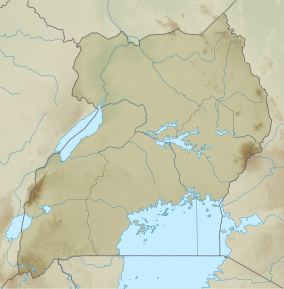| Kapimpini Central Forest Reserve | |
|---|---|
| Kapimpini Forest | |
| Location | Nakaseke District |
| Coordinates | 0°59′28″N 32°03′51″E / 0.9911°N 32.0641°E[2] |
| Established | 1967 |
| Governing body | National Forestry Authority |
Kapimpini Central Forest Reserve is a protected high forest located in Nakaseke district Uganda.[3] It covers a total area of 6,068 hectares (60.78 km2).[4][3] It was designated as a forest reserve in 1967.[5] It is under the management of National Forestry Authority.[6]
Conservation status
[edit]In 2009, 71 hectares of the forest had been deforested [7]
Over 2,000 residents who settled in Kapimpini Forest Reserve accused Nakaseke District Security Internal officer (DISO) and his deputy for threatening them to be evicted from the forest reserve, abuse of office and exorting money from them. But the DISO denied the claims of extortion.[6]
Threats
[edit]Grazing of large herds of livestock during the dry season in the forest reserves, commercial forest farming, fires.[8]
See also
[edit]- Bujawe Central Forest Reserve
- Guramwa Central Forest Reserve
- Kalinzu Central Forest Reserve
- Kasagala Central Forest Reserve
- List of Central Forest Reserves of Uganda
References
[edit]- ^ Protected Area Profile for Kapimpini Forest Reserve from the World Database on Protected Areas. Retrieved September 5, 2023.
- ^ "OpenStreetMap". OpenStreetMap. Retrieved 2023-05-29.
- ^ a b The Forests (Forest Reserves) (Declaration) Order. Uganda: Uganda Online Law Library.
- ^ NATIONAL BIOMASS STUDY (PDF). Uganda: National Forest Authority. 2009. p. 96.
- ^ "2018 United Nations List of Protected Areas of Uganda". documents.protectedplanet.net. Retrieved 2023-05-26.
- ^ a b Brian, Luwaga (2014-08-14). "Forest Reserve Settlers Accuse Nakaseke DISOs of Extortion". Uganda Radio Network. Retrieved 2023-05-29.
- ^ NATIONAL BIOMASS STUDY (PDF). Uganda: National Forest Authority. 2009. p. 96.
- ^ STATE OF UGANDA'S FORESTRY 2016 (PDF). Uganda: MINISRTY OF WATER AND ENVIRONMENT. 2016. p. 27.

Well, that’s interesting to know that Psilotum nudum are known as whisk ferns. Psilotum nudum is the commoner species of the two. While the P. flaccidum is a rare species and is found in the tropical islands. Both the species are usually epiphytic in habit and grow upon tree ferns. These species may also be terrestrial and grow in humus or in the crevices of the rocks.
View the detailed Guide of Psilotum nudum: Detailed Study Of Psilotum Nudum (Whisk Fern), Classification, Anatomy, Reproduction